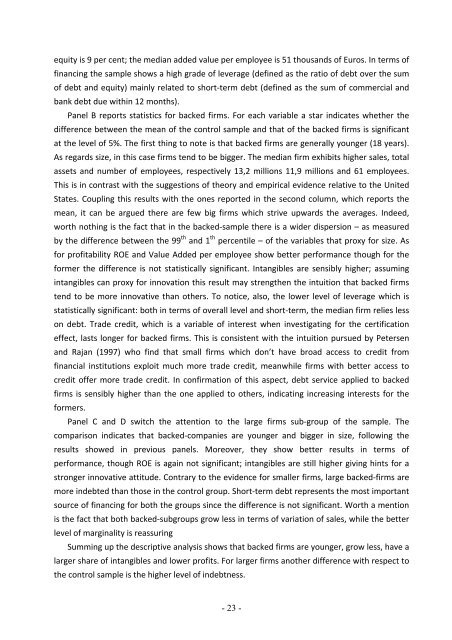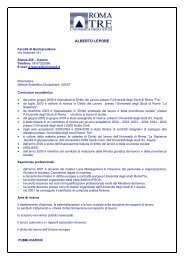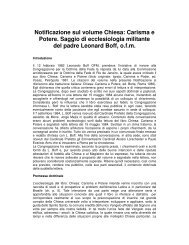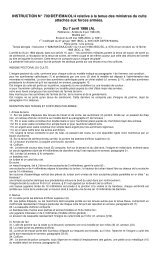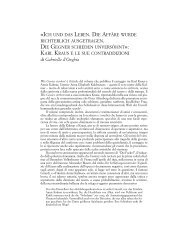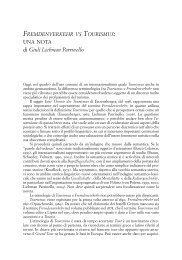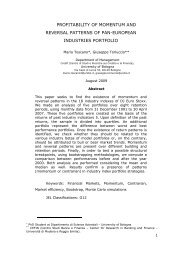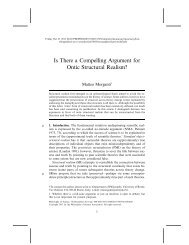Determinants and effects of Venture Capital and Private Equity ...
Determinants and effects of Venture Capital and Private Equity ...
Determinants and effects of Venture Capital and Private Equity ...
You also want an ePaper? Increase the reach of your titles
YUMPU automatically turns print PDFs into web optimized ePapers that Google loves.
equity is 9 per cent; the median added value per employee is 51 thous<strong>and</strong>s <strong>of</strong> Euros. In terms <strong>of</strong><br />
financing the sample shows a high grade <strong>of</strong> leverage (defined as the ratio <strong>of</strong> debt over the sum<br />
<strong>of</strong> debt <strong>and</strong> equity) mainly related to short‐term debt (defined as the sum <strong>of</strong> commercial <strong>and</strong><br />
bank debt due within 12 months).<br />
Panel B reports statistics for backed firms. For each variable a star indicates whether the<br />
difference between the mean <strong>of</strong> the control sample <strong>and</strong> that <strong>of</strong> the backed firms is significant<br />
at the level <strong>of</strong> 5%. The first thing to note is that backed firms are generally younger (18 years).<br />
As regards size, in this case firms tend to be bigger. The median firm exhibits higher sales, total<br />
assets <strong>and</strong> number <strong>of</strong> employees, respectively 13,2 millions 11,9 millions <strong>and</strong> 61 employees.<br />
This is in contrast with the suggestions <strong>of</strong> theory <strong>and</strong> empirical evidence relative to the United<br />
States. Coupling this results with the ones reported in the second column, which reports the<br />
mean, it can be argued there are few big firms which strive upwards the averages. Indeed,<br />
worth nothing is the fact that in the backed‐sample there is a wider dispersion – as measured<br />
by the difference between the 99 th <strong>and</strong> 1 th percentile – <strong>of</strong> the variables that proxy for size. As<br />
for pr<strong>of</strong>itability ROE <strong>and</strong> Value Added per employee show better performance though for the<br />
former the difference is not statistically significant. Intangibles are sensibly higher; assuming<br />
intangibles can proxy for innovation this result may strengthen the intuition that backed firms<br />
tend to be more innovative than others. To notice, also, the lower level <strong>of</strong> leverage which is<br />
statistically significant: both in terms <strong>of</strong> overall level <strong>and</strong> short‐term, the median firm relies less<br />
on debt. Trade credit, which is a variable <strong>of</strong> interest when investigating for the certification<br />
effect, lasts longer for backed firms. This is consistent with the intuition pursued by Petersen<br />
<strong>and</strong> Rajan (1997) who find that small firms which don’t have broad access to credit from<br />
financial institutions exploit much more trade credit, meanwhile firms with better access to<br />
credit <strong>of</strong>fer more trade credit. In confirmation <strong>of</strong> this aspect, debt service applied to backed<br />
firms is sensibly higher than the one applied to others, indicating increasing interests for the<br />
formers.<br />
Panel C <strong>and</strong> D switch the attention to the large firms sub‐group <strong>of</strong> the sample. The<br />
comparison indicates that backed‐companies are younger <strong>and</strong> bigger in size, following the<br />
results showed in previous panels. Moreover, they show better results in terms <strong>of</strong><br />
performance, though ROE is again not significant; intangibles are still higher giving hints for a<br />
stronger innovative attitude. Contrary to the evidence for smaller firms, large backed‐firms are<br />
more indebted than those in the control group. Short‐term debt represents the most important<br />
source <strong>of</strong> financing for both the groups since the difference is not significant. Worth a mention<br />
is the fact that both backed‐subgroups grow less in terms <strong>of</strong> variation <strong>of</strong> sales, while the better<br />
level <strong>of</strong> marginality is reassuring<br />
Summing up the descriptive analysis shows that backed firms are younger, grow less, have a<br />
larger share <strong>of</strong> intangibles <strong>and</strong> lower pr<strong>of</strong>its. For larger firms another difference with respect to<br />
the control sample is the higher level <strong>of</strong> indebtness.<br />
- 23 -


